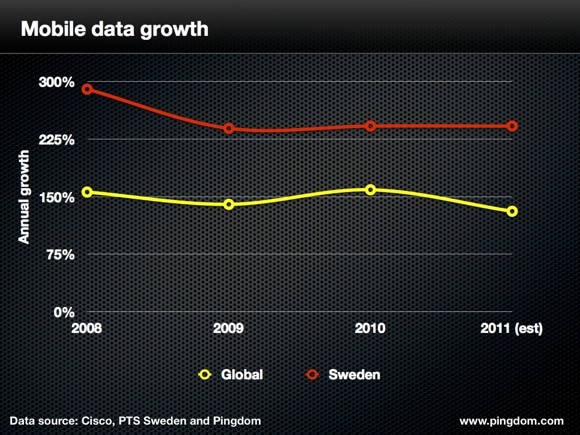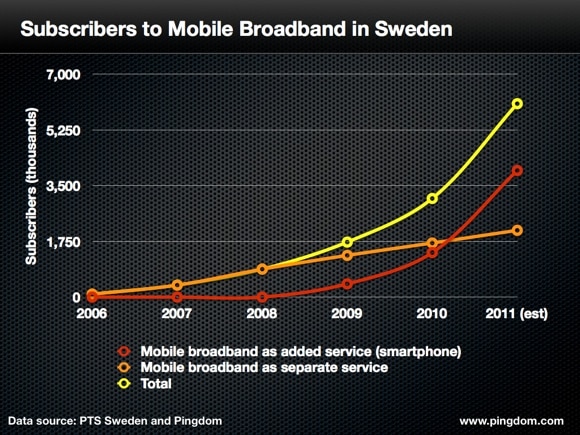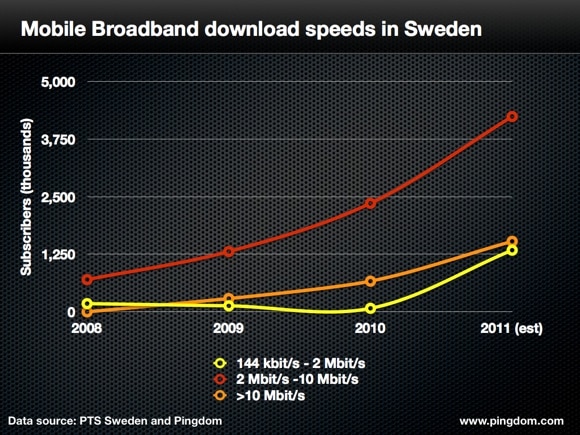 Mobile Internet adoption and speeds are increasing across the world. Sweden is one example of a country where Internet connections – mobile as well as fixed – are plentiful and fast.
Mobile Internet adoption and speeds are increasing across the world. Sweden is one example of a country where Internet connections – mobile as well as fixed – are plentiful and fast.
The Swedish Post and Telecom Authority (PTS) is in charge of monitoring the electronic communications and postal sectors in the country. In the latest report from PTS on telephony and the Internet, which covers the development through the the first half of 2011, we found some nuggets of information in terms of mobile data subscribers and traffic we felt worthy of a comparison to what’s happening globally.
These numbers should also be a good indication of how rapidly mobile Internet use is ramping up in other, similar countries (for example the rest of Scandinavia).
Mobile data traffic growing fast
On a global level mobile data is growing at an astounding rate, both in terms of users as well as traffic. Cisco expects mobile data use to increase by a factor of 26 by 2015. The prediction is that mobile data traffic will grow from 0.6 EB (exabytes) in 2011 to 6.3 EB in 2015. Similarly, Ericsson forecasts a 10-fold increase in mobile data traffic by 2016.
According to the PTS, mobile data traffic in Sweden more than doubled in 2010. If we assume a similar growth in 2011, which is a very conservative measure, Sweden’s mobile users will consume just over 100 PB (petabytes) this year, up from 53.1 PB in 2010. We have made the same assumption about complete 2011 numbers in the rest of the article, therefore they are marked as estimates.

If we take Cisco’s numbers for mobile data growth and compare them to the ones from PTS in Sweden, we get an interesting picture.
| Year | Global (from Cisco) | Sweden (from PTS) |
|---|---|---|
| 2008 | 156% | 290% |
| 2009 | 140% | 239% |
| 2010 | 159% | 242% |
| 2011 (estimate) | 131% | 242% |
You can see that the growth of mobile data in Sweden outpaces the growth in the rest of the world. This doesn’t necessarily mean that the growth in Sweden outpaces the growth in all other individual countries however. Let’s see those numbers in a chart.

Smartphones growing the most
Now let’s examine what kind of mobile data traffic it is that accounts for this increase.
PTS reports mobile subscriptions in two categories:
- What it refers to as mobile broadband as an added service basically means smartphones. In those cases mobile data (at least 1 GB per month to be included) is an addition to a voice service, either added on after the fact or included as a part when a user signed up for the service.
- The other category, broadband as a separate service, basically means USB dongles and other forms of data-only subscriptions. This would presumably also include tablets with data-only SIM cards.

Almost 1 GB per subscription per month
Even though it’s clearly the smartphone subscriptions that increase the most, it’s the non-smartphone connections that take the bulk of data traffic.
On average, according to PTS, a smartphone subscription in Sweden used up 420 MB of data per month in 2010, which has increased to 579 MB per month in the first half of 2011. That should mean smartphone data traffic will triple this year.
For non-smartphone data traffic, the corresponding numbers were 2,557 MB per month in 2010 and 3,200 MB per month in the first half of 2011.
Divided over the estimated total number of mobile data subscriptions for 2011, around 9.3 million, the numbers by PTS would put average mobile data consumption in Sweden at 918 MB per month per subscription. Note that PTS reports the figures by subscription or account, not per actual user.
Mobile speeds also increasing
Finally, let’s also look at speed of mobile data connections.
Not only do Swedes download more than they used to with their mobile devices, but they are able to do so at faster and faster speeds.
Mobile broadband connection speeds between 2 and 10 Mbit/s have already for several years been the most common. Connections below 2 Mbit/s have increased their share, but it would appear that faster connections, those above 10 Mbit/sec will remain more popular.

As far as we can tell 4G is included in the numbers from PTS, but it’s not likely to have had any significant effect yet. PTS reports that only 8,600 4G subscriptions were active in the second quarter of 2011. Once 4G-enabled mobile devices become more common, we can probably expect these numbers to increase even more rapidly.
Interesting snapshot
We hope to take a look at other countries in terms of telecommunications and technology but Sweden made a good case to start with not only because we’re based here.
With smartphones on the rise all over the world, it’s likely that this local snapshot of Sweden’s mobile traffic growth is mirrored in most other countries, although perhaps not always to the same degree.



























